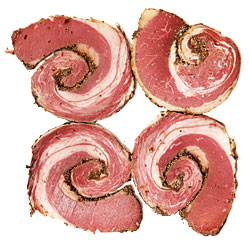
Once ubiquitous at Jewish delicatessens, rolled beef has become the giant panda of deli meats: all but impossible to find in its native habitat. The cold cousin of pastrami requires skilled hands to properly roll, tie, and slice, a time-consuming process. Large purveyors like Hebrew National discontinued it years ago, and smaller operations, like Empire National, can’t afford the labor needed to turn it out regularly (it makes about two per month). Enter Dickson’s Farmstand Meats, the boutique butcher at Chelsea Market, where chef Gabriel Ross resurrected the retro deli cut by accident. Faced with a surplus of navels, the fatty belly cut used to make pastrami, Ross decided to try rolling them like porchetta. Unbeknownst to him, the only difference in deli parlance between rolled beef and pastrami is the rolling and the temperature at which it’s served (the former cold, the latter hot). The cure and rub are identical: Ross brines his pasture-raised navels for three-to-five days, then rubs them with a blend of black pepper, coriander, mustard seed, garlic, and palm sugar. After a day or two, the spiced navels are tightly rolled and tied with a web of twine, then smoked for eight-to-ten hours, and finally steamed. Sliced cold and thin ($18 a pound), most of Dickson’s rolled beef gets sold in its “pastrami” sandwich ($8); a quarter-pound layered between rye, spread with A. Bauer’s brown mustard and Hellmann’s mayonnaise (oy vey), and topped with the shop’s own sauerkraut and pickled onions. While this discovery might come as big news to kosher-style connoisseurs, Ross has no plans to rename his sandwich. “Most of our customers just want pastrami.”